![]() Quilting is the stitching which holds the three layers of the quilt 'sandwich'
together while forming a decorative design. Quilting can be done either by hand
or machine.
Quilting is the stitching which holds the three layers of the quilt 'sandwich'
together while forming a decorative design. Quilting can be done either by hand
or machine.
![]() Hand quilting is usually done in a quilting 'hoop' or on a quilting
'frame' using special needles, called 'betweens',
and quilting thread. The stitches are usually executed with one hand; the other
hand kept underneath the quilt to feel for the needle. A hand quilter prides
his/herself on making small, uniform running stitches. It is more important,
however, that the stitches be straight and uniform than they be tiny. Either
way, these stitches must go through to the backing, preferably to be the same
size on the bottom as on the top.
Hand quilting is usually done in a quilting 'hoop' or on a quilting
'frame' using special needles, called 'betweens',
and quilting thread. The stitches are usually executed with one hand; the other
hand kept underneath the quilt to feel for the needle. A hand quilter prides
his/herself on making small, uniform running stitches. It is more important,
however, that the stitches be straight and uniform than they be tiny. Either
way, these stitches must go through to the backing, preferably to be the same
size on the bottom as on the top.
![]() Machine quilting is usually done on a regular sewing machine, using a 'walking
foot' to help all the layers feed smoothly though the machine. 'Freehand' or
'free motion' quilting is done with a 'darning foot'. Machine quilters will
often match the threads to the fabric that they're quilting. Invisible
monofilament thread is used when matching is not possible.
Machine quilting is usually done on a regular sewing machine, using a 'walking
foot' to help all the layers feed smoothly though the machine. 'Freehand' or
'free motion' quilting is done with a 'darning foot'. Machine quilters will
often match the threads to the fabric that they're quilting. Invisible
monofilament thread is used when matching is not possible.
![]() The design that is created by either method is visible as a 'shadow line'. Each
method creates a different shadow line. Hand quilting yields a dotted, puckering
line, while machine quilting, although faster, gives a straighter, finer line
and a harsher look. Hand quilting seems softer and more dimensional than machine
quilting. Each method has its advantages and disadvantages, in terms of speed
and results, and its very vocal advocates.
The design that is created by either method is visible as a 'shadow line'. Each
method creates a different shadow line. Hand quilting yields a dotted, puckering
line, while machine quilting, although faster, gives a straighter, finer line
and a harsher look. Hand quilting seems softer and more dimensional than machine
quilting. Each method has its advantages and disadvantages, in terms of speed
and results, and its very vocal advocates.
1) Ditch: quilting very close to the seamline of a patch, block or
border. Quilting 'in the ditch' is usually done on the 'low' side of the
seamline (the side without the seam allowance) and is almost invisible:

2) Outline: quilting inside each patch, usually about 1/4" away
from the seamline. This method avoids seam allowances and lends the most
strength to the quilt:
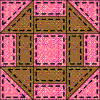
3) Motif: quilting that follows the lines of a design that is
drawn onto the quilt top (e.g. feathers, bows, birds, hearts, wreaths, etc.):
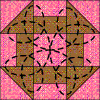
4) Accent: quilting that complements, rather than follows,
existing seamlines:
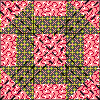
5) Selective: quilting only certain portions of a design to
emphasize them:
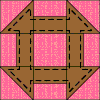
6) Fill: quilting that fills in and flattens background or
'negative' space in the quilt top to make the primary design stand out. Some
types of fill quilting are:
echoes the shapes of the patchwork or Appliqué with two or more lines of stitches spaced about 1/4" apart:a) Echo:
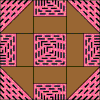
b) Channel: quilting done in straight, parallel lines:
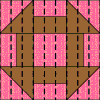
c) Crosshatching: straight line quilting done in a grid
pattern. This grid can be straight or diagonal and can form either squares or
diamonds where the lines cross. Plaids are possible with creative spacing of
the lines:
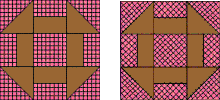
d) * Meandering: quilting done 'freehand' in random curved
lines and swirls. This quilting does not follow any pattern but depends
completely on the quilter's whim. Lines should not cross or touch each other:
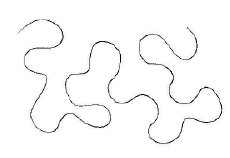
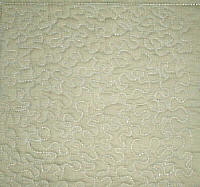
e) Stippling: very closely spaced echo or meandering stitches
meant to flatten down an area completely:
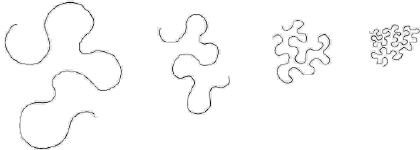
7) Allover: quilting that fills the entire top in a design that completely ignores the seamlines (e.g. clamshells, Baptist Fans, crosshatching, etc.):

* All of the above quilting types can be done either by hand or machine. However, meandering is most suited to freehand machine quilting with a darning foot.
[Click HERE for LIVE Chat NOW!!!]
[ChanOps]
[Chat]
[Stats] [Schedule] [SuperChats]
[Lessons] [Links]
[Send a Quilty Postcard to your
Friends!!!]
![]()